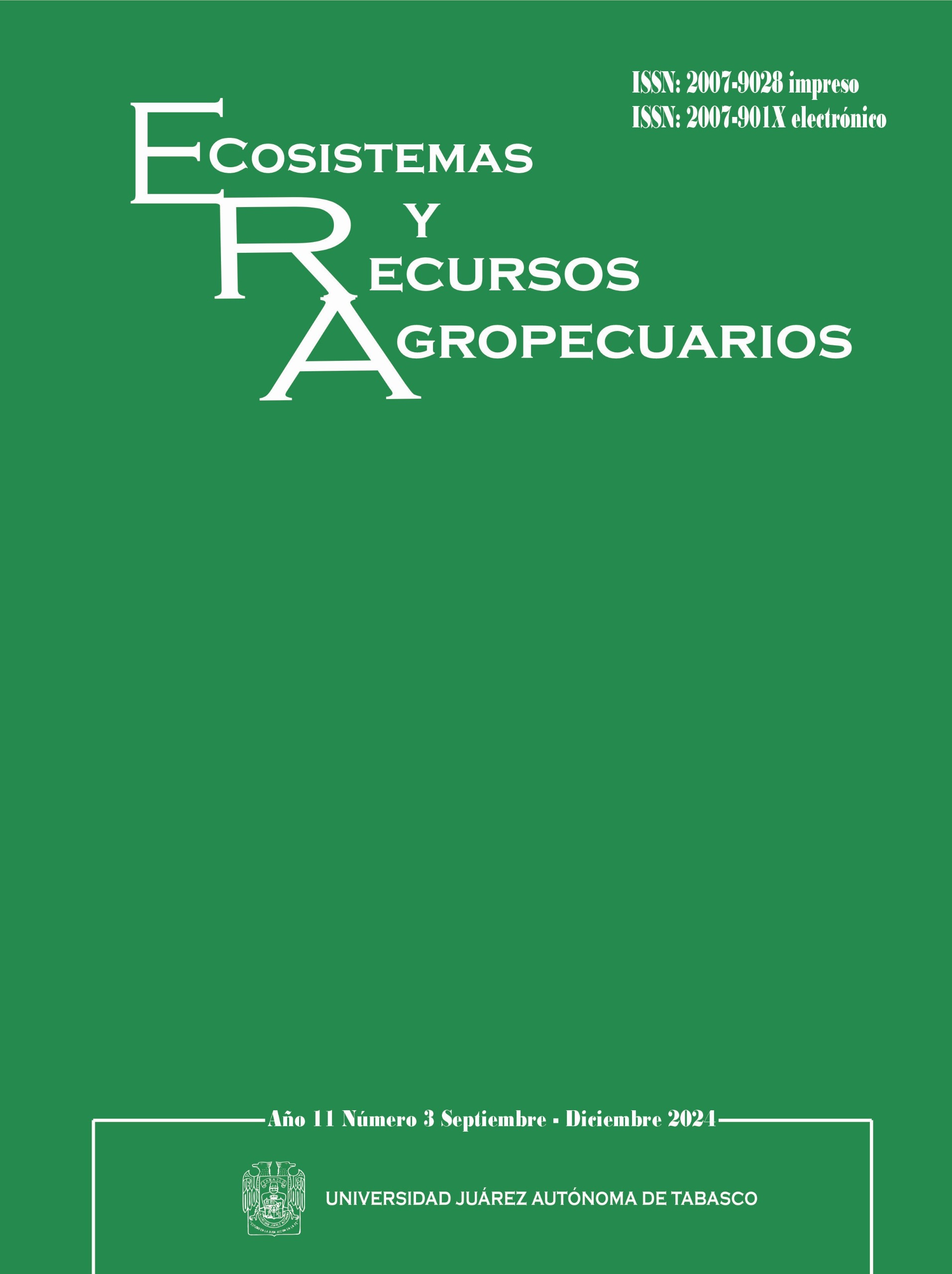Soil resilience in agricultural systems in the Calimaya municipality
DOI:
https://doi.org/10.19136/era.a11n3.3466Keywords:
Soil QualityAbstract
The rainfed agriculture of the State of Mexico presents physical and chemical degradation processes that affect soil's quality. The objective was to analyze the resilience of agricultural soils in the presence of these processes in the production of maize and potato, in the municipality of Calimaya, State of Mexico. The methodology integrates the evaluation of soil quality through physical and chemical indicators. Three patterns were identified: two of rainfed maize systems and one of potato. The degradative processes derived from agricultural management decrease the quality of the soils in the area, translated into the loss of structure and porosity and the availability of nutrients. It was identified that the low rating of soil indicators affects its short-term resilience, which is supported by the inclusion of external inputs and incipient empirical practices that maintain agricultural production profitability.
Downloads
References
Abreu LGAH, Escalona VRA, Espinosa RLM, Juan PJI, Balderas PMÁ (2022) Contexto ambiental de los procesos de cambio de uso y cobertura del suelo en Calimaya, Altiplano Mexicano. Revista Geográfica de América Central 1(70): 221-241. https://doi.org/10.15359/rgac.70-1.8
Álvarez-Arteaga G, Ibáñez-Huerta A, Orozco-Hernández ME, García-Fajardo B (2020) Regionalización de indicadores de calidad para suelos degradados por actividades agrícolas y pecuarias en el altiplano central de México. Quivera. Revista de Estudios Territoriales 22(2): 5-19. https://doi.org/10.36677/qret.v22i2.13302
Assarkhaniki Z, Rajabifard A, Sabri S (2020) The conceptualisation of resilience dimensions and comprehensive quantification of the associated indicators: A systematic approach. International Journal of Disaster Risk Reduction 51: 101840. https://doi.org/10.1016/j.ijdrr.2020.101840
Ayuntamiento de Calimaya (2022) Medio físico Calimaya. https://calimaya.gob.mx/tu-municipio/medio-fisico. Municipio de Calimaya, México. Fecha de consulta 11 de Agosto de 2022.
Bobadilla JG, Pérez LD, González HA, Sangerman-Jarquin D, Navarro BA (2019) Estudio preliminar para determinar diferencia y tamaño de muestra en maíz Cacahuacintle. Revista Mexicana de Ciencias Agrícolas 10: 1771-1782. https://doi.org/10.29312/remexca.v10i8.1765
Buitenhuis Y, Candel LJJ, Termeer JAMK, Feindt HP (2020) Does the common agricultural policy enhance farming systems’ resilience? Applying the resilience assessment rool (ResAT) to a farming system case study in the Netherlands. Journal of Rural Studies 80: 314-327
Castillo-Valdez X, Etchevers JD, Hidalgo-Moreno C, Aguirre-Gómez A (2021) Evaluación de la calidad del suelo: generación e interpretación de indicadores. Terra Latinoamericana 39: 1-12. https://doi.org/10.28940/terra.v39i0.698
Chatterjee R, Acharya SK, Biswas A, Mandal A, Biswas T, Das S, Mandal B (2021) Conservation agriculture in new alluvial agro-ecology: Differential perception and adoption. Journal of Rural Studies 88: 14-27. https://doi.org/10.1016/j.jrurstud.2021.10.001
Dardonville M, Bockstaller C, Villerd J, Therond O (2022) Resilience of agricultural systems: biodiversity-based systems are stable, while intensified ones are resistant and high-yielding. Agricultural Systems 197: 103365. https://doi.org/https://doi.org/10.1016/j.agsy.2022.103365
Food and Agriculture Organization of United Nations (2008) Visual soil assessment. Field Guides FAO.
https://www.fao.org/4/i0007e/i0007e00.htm. Fecha de consulta: 11 de Agosto de 2022.
Fanchone A, Alexandre G, Chia E, Diman JL, Ozier-Lafontaine H, Angeon V (2020) A typology to understand the diversity of strategies of implementation of agroecological practices in the French West Indies. European Journal of Agronomy 117: 126058. https://dx.doi.org/10.1016/j.eja.2020.126058
Ibarrola-Rivas MJ, Castillo G, González J (2020) Social, economic and production aspects of maize systems in Mexico. Investigaciones Geográficas 102: 1-18.
Insituto Nacional de Estadistica y Geografía (2010) Compemdio de informacion geográfica municipal 2010 Calimaya. Instituto Nacional de Estadística y Geografia.
Karim AR, Darsono, Harisudin M. Dharmawan B (2023) Potato cultivation on the west slope of Mount Slamet: millennial farmers perceptions and intentions for conservation-based farming. IOP Conference Series.: Earth Environmental Sciences 1180. https://dx.doi.org/10.1088/1755-1315/1180/1/012054
López Mejía FX, Muñoz Flórez JE, Vivas Cedeño JS, Cedeño Zambrano JR, Tacuri Troya E, Cruzatty Loor NM (2022) Caracterización de agrosistemas productores de plátano (Musa AAB) en los cantones Santo Domingo y El Carmen, Ecuador. Idesia 40(4): 45-52. https://dx.doi.org/10.4067/S0718-34292022000400045
Ludwing M, Wilmes P, Scharader S (2018) Measuring soil sustainability via soil resilience. Science of the Total Environment 626: 1484-1493. https://doi.org/10.1016/j.scitotenv.2017.10.043
Martínez-Alba G, Gutierrez-Ruiz, Martínez-Campos A.R, Villalobos Pietrini R, Arteaga-Reyes TT (2015) Concentracion total y geodisponible de elementos potencialmente tóxicos en suelos volcánicos con uso agrícola del Nevado de Toluca, México. Revista Internacional de Contaminación Ambiental 31(2): 113-125.
Mathijs E, Wauters E (2020) Making farming systems truly resilient rendre les systèmes agricoles vraiment résilients Landwirtschaftssysteme wirklich resilient machen. EuroChoices 19: 72-76. https://doi.org/10.1111/1746-692X.12287
Meuwissen MPM, Feindt PH, Slijper T, Spiegel A, Finger R, Y. de Mey, Paas W, Termeer KJAM, Poortvliet PM, Peneva M, Urquhart , J. Vigani M, Black , JEP, Davies N, Maye D, Appel F, Heinrich F, Balmann A, Bijttebier J, Coopmans I, Wauters E, Mathijs E, Hanssony H, Lagerkvist CJ, Rommel J, Manevska-Tasevska G, Accatino F, Pineau C, Soriano B, Bardaji I, Severini S, Senni S, Zinnanti C, Gavrilescu C, Bruma IS, Dobay KM, Matei D, Tanasa L, Voicilas DM, Zawalińska K,Gradziuk P, Krupin V, Martikainen A, Herrera H, Reidsma P (2021) Impact of Covid-19 on farming systems in Europe through the lens of resilience thinking. Agricultural Systems 191: 1-12. https://doi.org/10.1016/j.agsy.2021.103152
Min-Suk K, Hyun-Gi M, Seung-Hun H, Jeong-Gyu K (2020) Soil resilience and threat factors related to agricultural environment. Ecology and resilient infrastructure 71: 26-46. https://doi.org/10.17820/eri.2020.7.1.02
Paas W, San Martín C, Soriano B, van Ittersum KM, Meuwissen PMM, Reidsma P (2021) Assessing future sustainability and resilience of farming systems with a participatory method: A case study on extensive sheep farming in Huesca, Spain. Ecological Indicators 132: 1-18. https://doi.org/10.1016/j.ecolind.2021.108236
Rebollar-Rebollar E, Rebollar-Rebollar A, Rebollar-Rebollar S, Hernández-Martínez J, Gómez-Tenorio G, González-Razo FJ (2019) Participacion y especialización de los granos de consumo pecuario en México, 2003-2013. Agricultura Sociedad y Territorio 16: 141-158. https://doi.org/10.22231/asyd.v16i2.1004
Soares Franco HH, Locks Guimarães RM, Tormena CT, Maurício Cherubin MR, Sasso Favilla H (2019) Global applications of the Visual Evaluation of Soil Structure method: A systematic review and meta-analysis. Soil and Tillage Research 190: 61-69. https://doi.org/10.1016/j.still.2019.01.002
Téllez-Silva JM, Herrera-Tapia F, Vizcarra-Bordi I, Ramírez -Hernández JJ (2016). El maíz cacahuacintle y su potencial para el desarrollo endógeno: el caso de Santa María Nativitas. Espacialidades. Revista de Temas Contemporáneos sobre Lugares, Política y Cultura 6(1): 168-191.
Valencia García EJ, Juan Pérez JI y Estrada Olivella R (2022) Recuperación ambiental y bienestar social en México: El caso de Calimaya, Estado de México. Revista Desarrollo Local Sostenible 9(25).
Downloads
Published
Issue
Section
License
Copyright (c) 2024 Ecosistemas y Recursos Agropecuarios

This work is licensed under a Creative Commons Attribution-NonCommercial-ShareAlike 4.0 International License.
Aviso de copyright
Los autores que se envían a esta revista aceptan los siguientes términos:
una. Los autores conservan los derechos de autor y garantizan a la revista el derecho a ser la primera publicación del trabajo con una licencia de atribución de Creative Commons que permite a otros compartir el trabajo con un reconocimiento de la autoría del trabajo y la publicación inicial en esta revista.
B. Los autores pueden establecer acuerdos complementarios separados para la distribución no exclusiva de la versión del trabajo publicado en la revista (por ejemplo, en un repositorio institucional o publicarlo en un libro), con un reconocimiento de su publicación inicial en esta revista.
C. Se permite y se anima a los autores a difundir su trabajo electrónicamente (por ejemplo, en repositorios institucionales o en su propio sitio web) antes y durante el proceso de envío, ya que puede conducir a intercambios productivos, así como a una cita más temprana y más extensa del trabajo publicado. (Consulte El efecto del acceso abierto).


